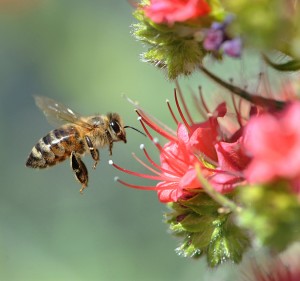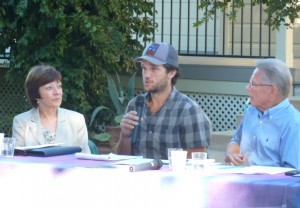As published in Ag Alert, a publication of the California Farm Bureau Federation
Date: October 5, 2011
By Karen Ross and Kerry Tucker
A focus in many food policy discussions is the development of a substantial food system to feed a hungry world, and the trends we’re seeing internationally show there is an urgent need. Food has become a geopolitical hot potato this year. The uprisings in the Middle East and Africa reaffirm that food is a basic building block for peace, harmony and, of course, survival.
An article this year in the publication Foreign Policy spotlighted a world population that continues to explode, while farm production struggles to keep pace. As a result, world food prices are at an all-time high, according to the U.N. Food Price Index. Every day, there are nearly 220,000 new mouths to feed on the planet—a staggering number. By 2050, it is believed the world must double food production, while using fewer natural resources. All of this brings challenges and opportunities for California agriculture.
New, affluent sectors in countries around the world are on a growth spurt for the foreseeable future, with an anticipated growing demand for the type of products California farmers produce: animal proteins and specialty crops. The leading countries with emerging affluent sectors include China, India, Brazil, Korea and Mexico.
According to the Agricultural Issues Center at the University of California, Davis, China will more than triple its per capita income by 2030, from $2,802 to $10,718. This kind of wealth generation tends to result in first-step dietary adjustments that include more consumption of meat, dairy products, fruits, vegetables and nuts.
India’s numbers start smaller, from $965 per capita last year to $3,309 in 2030, but its population will continue to grow by 1 percent per year long after China’s population peaks in about 2030, according to Daniel Sumner, director of the AIC. As a result, India’s population will stay young and energetic for years to come, with a growth rate that could soon overtake China.
The food industry is well aware of these numbers. Companies like Nestlé, Procter and Gamble, Unilever, Heinz and Walmart have these countries in their sights. The food they’ll provide could easily be produced in California.
Because they’re located in one of only five regions on Earth capable of large-scale production of Mediterranean specialty crops, California farmers and ranchers are well positioned to prosper in the international marketplace.
Also working to the state’s advantage is the health profile of its product line. The 2011 Food Foresight trend report shows concern for obesity and diabetes rising worldwide. Add the rising cost of health care to the discussion and it’s bound to move nutrition and disease prevention center-stage in the health care debate, spotlighting foods thought to protect against the development of chronic disease—foods that are produced in California. This opportunity exists for all types of the state’s farmers and ranchers.
California agriculture is incredibly diverse: large farms and small, plants and animals, food and fiber, organic, conventional and biotech. It includes urban farmers, farmworkers and minority farmers. This diversity makes California agriculture stronger and more successful.
There is keen consumer interest in the thriving trend of local, regional food systems—the growth of farmers markets, CSAs and other direct-to-consumer marketing opportunities that are shortening the distance between eaters and farmers. This is the new and exciting frontier in our domestic markets; it presents opportunities for collaboration in the public policy arena. To encourage local farming, we must preserve farmland and maintain access to affordable water. There are enormous possibilities for agriculture if it works together to build new coalitions.
Yet there is tension in the search for common ground. Some consumer and stakeholder perceptions—small farms are good, “Big Ag” is bad—can get in the way of the cooperation required to meet the food demands of the future. On the other hand, belittling small, organic farms as unable to address global food security issues, or the demonization of one agricultural segment by another (“My way of farming is better than yours”) is not constructive. Regardless of size or farming practices, we need a continuum of farms and ranches operating as productively as possible while protecting our precious natural resources and the environment. There is truly a place for all in California agriculture.
One way to build coalitions is Ag Vision, a program spearheaded by the California State Board of Food and Agriculture to bring together diverse stakeholders who share a common goal: the long-term viability of California agriculture. Ag Vision is not the only answer but it is a good beginning, because this diverse group working with farmers and ranchers has spent more than two years focusing on what they could agree on, rather than fight over their differences.
This process will continue, with the goal being an agricultural system working harmoniously to meet the international opportunities and challenges ahead. The co-chairs of this effort are board member Luawanna Hallstrom and American Farmland Trust’s Ralph Grossi, who, along with board president Craig McNamara, would enthusiastically welcome your participation. For more information, see www.cdfa.ca.gov/agvision/.
We also urge you to join us in planning for the next farm bill. It is essential that we receive input from stakeholders about California’s priorities. This is the national food policy discussion—right now—and the farm bill will set the agenda. So let’s get together as one voice and set the tone for a future of collaboration.
(Karen Ross is secretary of the California Department of Food and Agriculture. Kerry Tucker is chief executive officer of the public relations consulting firm Nuffer, Smith and Tucker, and a member of the State Board of Food and Agriculture.)





